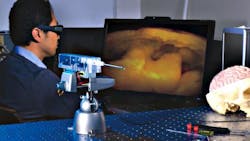| MARVEL (seen at center foreground), one of the world's smallest 3D cameras, is designed for use in brain surgery. On the display is a 3D image of the interior of a walnut taken by MARVEL previously (a walnut is a good test subject because it has geometrical characteristics similar to that of a brain). (Credit: NASA/JPL-Caltech/Skull Base Institute) |
Scientists at NASA's Jet Propulsion Laboratory (JPL; Pasadena, CA) are developing an endoscope with a miniature stereo camera designed to produce 3D images from inside the brain to assist in brain surgery. The camera is a mere 4 mm in diameter and 15 mm long.
The endoscope, the multi-angle rear-viewing endoscopic tool (MARVEL), includes a bendable neck that can sweep left or right, looking around corners with up to a 120° arc.
"With one of the world's smallest 3D cameras, MARVEL is designed for minimally invasive brain surgery," says Harish Manohara, principal investigator of the project at JPL. Manohara is working in collaboration with surgeon Dr. Hrayr Shahinian at the Skull Base Institute (Los Angeles, CA), who approached JPL to create this technology.
Operations with the small camera would not require the traditional open craniotomy, a procedure in which surgeons take out large parts of the skull. Craniotomies result in higher costs and longer stays in hospitals than surgery using an endoscope.
Single camera
Stereo imaging endoscopes that employ traditional dual-camera systems are already in use for minimally invasive surgeries elsewhere in the body; however, surgery on the brain requires even more miniaturization. As a result, the JPL researchers designed MARVEL to have only one camera and lens.
To generate 3D images, MARVEL's camera has two separate apertures, each offset laterally in the opposite direction of the other and each with its own color filter. Each filter transmits three narrow spectral bands of red, green and blue light, while blocking the bands to which the other filter is sensitive. The system includes a light source that produces all six of the filters' spectral bands. The result is two full-color stereo images that can be merged to create a 3D effect.
Now that the researchers have demonstrated a laboratory prototype, the next step is to create a clinical prototype that meets the requirements of the U.S. Food and Drug Administration. The researchers will refine the engineering of the tool to make it suitable for use in real-world medical settings.
Possible use in space exploration
In the future, the MARVEL camera technology could also have applications for space exploration, according to JPL. A miniature camera such as this could be put on small robots that explore other planets, delivering intricate 3D views of geological features of interest.
"You can implement a zoom function and get close-up images showing the surface roughness of rock and other microscopic details," says Manohara.
